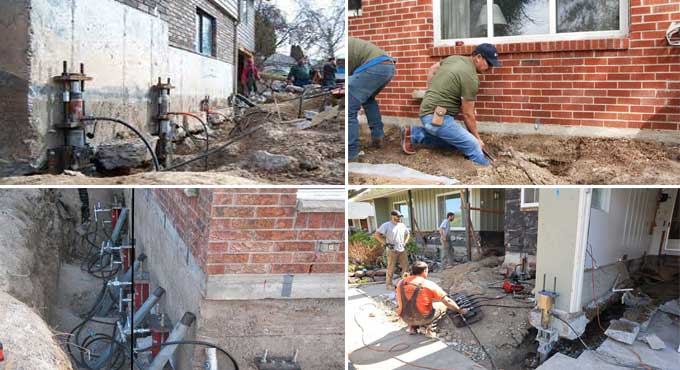NEWS | SOFTWARE | SHEET
Foundation Repair – Methods, Costs & Techniques (A Comprehensive Guide)
Your home's foundation is its structural backbone, and any issues with it can have significant repercussions. Foundation problems can manifest in various ways, from cracks in the walls to sloping floors.
Recognizing Foundation Issues
Before diving into the repair methods and costs, it is crucial to recognize the signs of foundation problems:
- Cracks: Horizontal, vertical, or diagonal cracks in walls or the foundation itself.
- Sloping or Uneven Floors: Floors that slope or feel uneven when walking on them.
- Doors and Windows: Doors or windows that stick or won't close properly.
- Gaps: Noticeable gaps around windows and doors.
- Bowed Walls: Walls that appear to bow inward or outward.
- Foundation Settling: Visible signs of foundation settling or sinking.
Understanding the signs can help you identify potential issues early, reducing the cost and complexity of repairs.
Common Foundation Repair Methods
When foundation problems arise, various repair methods can be employed, depending on the specific issue. Here are some common methods:
1. Foundation Piering
Foundation piering involves driving steel or concrete piers into the ground beneath the foundation to provide support. This method is effective for settling foundations and can be implemented in various ways, including helical piers, push piers, and underpinnings.
2. Slabjacking
Slabjacking, also known as mudjacking, is a process where a slurry of concrete, sand, and other materials is pumped beneath a sunken concrete slab. This raises the slab to its original position, effectively stabilizing the foundation.
3. Crawl Space Encapsulation
Crawl space encapsulation involves sealing off the crawl space beneath a house, preventing moisture from causing further foundation damage. It can also help improve indoor air quality and reduce energy costs.
4. Wall Anchors and Bracing
Wall anchors and bracing systems are used to stabilize bowing or leaning foundation walls. These systems use anchors and braces to pull the wall back into place, preventing further movement.
5. French Drains
French drains are used to manage water around the foundation. They consist of a perforated pipe surrounded by gravel that redirects water away from the foundation, helping to prevent soil erosion and settlement.
Factors Affecting Foundation Repair Costs
The cost of foundation repair can vary significantly based on several factors. You can estimate potential expenses by understanding these factors:
1. Foundation Type
Different foundation types, such as concrete slab, crawl space, or basement, have varying repair needs and costs.
2. Extent of Damage
The severity and extent of the foundation damage play a significant role in determining repair costs. Minor cracks may be less expensive to repair than extensive structural damage.
3. Repair Method
The chosen repair method can greatly influence the cost. Some methods, like slab jacking, are generally less expensive than extensive peering solutions.
4. Labour and Materials
The cost of labour and materials in your region can impact the overall repair expenses.
5. Permitting and Engineering
If your foundation repair requires permits or engineering services, these can add to the overall cost.
6. Additional Repairs
Sometimes, foundation problems are accompanied by other issues, like plumbing or drainage problems, which may require additional repair work.
Foundation Repair Techniques
A successful foundation repair project relies on a combination of techniques to ensure a long-lasting solution. Here are the key techniques employed during foundation repairs:
1. Inspection and Assessment
A thorough inspection is the first step. Engineers or foundation specialists assess the extent of damage, identify the underlying causes, and determine the most suitable repair methods.
2. Excavation and Access
In many cases, excavation is necessary to access the foundation. This can be a complex and labour-intensive process, especially for basements or crawl spaces.
3. Foundation Underpinning
Underpinning methods involve stabilizing and strengthening the foundation. This may include installing piers, helical anchors, or push piers to support and level the structure.
4. Grouting and Slabjacking
Grouting and slabjacking are used to fill voids beneath the foundation and lift it back into its proper position. These techniques are effective for sunken concrete slabs.
5. Waterproofing and Drainage
Improving drainage and preventing moisture infiltration is crucial to maintaining a stable foundation. Waterproofing membranes, French drains, and sump pumps are commonly used.
6. Bracing and Wall Anchoring
Bracing and wall anchoring techniques are employed to stabilize and reinforce foundation walls. This may involve the installation of wall anchors, braces, or carbon fiber strips.
DIY vs. Professional Foundation Repair
While some minor foundation issues can be addressed by homeowners, it is essential to understand the limitations of DIY repairs.
Major structural problems should be left to professionals who have the expertise and equipment to ensure a safe and effective repair. Attempting complex foundation repairs without the necessary knowledge can lead to costly mistakes and potentially hazardous conditions.
To get more details, go through the following video tutorial.
Lecturer: This Old House
The Importance of Timely Repair
Foundation problems typically worsen over time. Delaying repairs can result in increased damage and, consequently, higher repair costs. Moreover, ignoring foundation issues may lead to safety hazards and reduced property value. Timely action is crucial when foundation problems are identified.
A solid and stable foundation is the cornerstone of a safe and secure home. When issues arise, it is essential to address them promptly with professional assistance. Foundation repair methods, costs, and techniques may vary, but the ultimate goal remains the same: to restore the integrity of your home's foundation, ensuring its longevity and your peace of mind.
Recognizing the signs of foundation problems, understanding the factors affecting repair costs, and making informed decisions are all vital steps in maintaining a strong foundation for your home.


